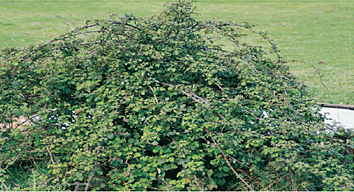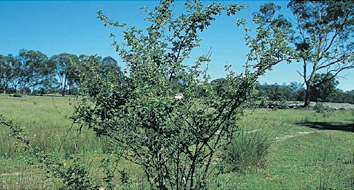Using the right spray volume is essential to ensure acceptable control. Applying too much is wasteful, and applying too little can mean having to go back to re-treat large amounts of regrowth. Always read the label for the application rate and critical comments.
Use the calibration charts below as a guide to the correct foliar spray volume you should be applying to a woody weed.
Calibration chart for dome-shaped weeds
Recommended volume for dome-shaped weeds such as blackberry and gorse:
Volume of spray per bush in L based on 3000–4000 L/ha
| Bush diameter (metres) | Bush height (metres) |
|---|
| | 1.5 | 2.0 | 2.5 |
|---|
| 4.0 |
7.0 |
10.5 |
15.0 |
| 4.5 |
8.6 |
13.6 |
17.6 |
| 5.0 |
10.4 |
14.9 |
20.6 |
| 5.5 |
12.3 |
17.6 |
23.8 |
| 6.0 |
14.4 |
20.4 |
27.3 |
Source: Max McMillan
Calibration chart for cylindrical/cone-shaped weeds
Recommended volume for cylindrical/cone-shaped weeds such as sweet briar, lantana, wattle and eucalypt regrowth:
Volume of spray per bush in L based on 3000–4000 L/ha
| | Bush height (metres) |
|---|
| | 1 | 2 | 3 |
|---|
| Bush diameter (metres) | Spray volume per bush (metres) |
|---|
| 1.0 |
160 |
240 |
310 |
| 2.0 |
630 |
940 |
1300 |
| 3.0 |
1400 |
2100 |
2800 |
| 4.0 |
2500 |
3800 |
5000 |
| Water rate L/ha |
2000 |
3000 |
4000 |
Source: Max McMillan
Adjuvants
Grazon® Extra Herbicide, Garlon® 600 Herbicide and Starane® Advanced Herbicide formulations already contain surfactants. The use of additional surfactants is not recommended except in specific situations as detailed on the label.
Rainfastness
GrazonExtra, Garlon600 and Starane Advanced are rainfast. Foliar application should be stopped if rain is likely within one hour or if foliage is wet. Amine 625 and Ripper® 480 are relatively rainfast; foliar application should be stopped if rain is likely within six hours.
Guideline to calibration
Use the correct spray nozzle (see chart)
Nozzles and pressures for different spray volumes
| Spray volume (L/ha) | Nozzle | Diameter (mm) | Output (L/min) | Pressure (kPa) |
|---|
| 1000–2000 |
D4 |
1.6 |
2.5 |
400 |
| 1500–3000 |
D5 |
2.0 |
3.8 |
500 |
| 2000–4000 |
D6 |
2.4 |
5.5 |
600 |
| 3000–6000 |
D7 |
2.8 |
7.8 |
700 |
| 4000–8000 |
D8 |
3.2 |
8.6 |
800 |
Reference: Scott, M. and Cook, T. (2007).
Spraying Woody Weeds. NSW DPI SMARTtrain Chemical Notes 2


Prior to spraying, select a bush to spray and decide what shape the weed can be categorised as (either dome or cylindrical). Spray that bush normally to achieve good coverage to the point of run-off. Time how long it took you to spray. Repeat this process spraying into a bucket. Measure the spray volume and compare this with the recommended spray and water rate using the tables attached. Installing a flow meter on the high-pressure hose next to the handgun will make calibration easier.